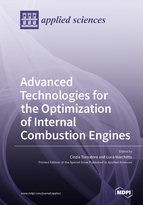Advanced Technologies for the Optimization of Internal Combustion Engines
A special issue of Applied Sciences (ISSN 2076-3417). This special issue belongs to the section "Mechanical Engineering".
Deadline for manuscript submissions: closed (31 May 2021) | Viewed by 29567
Special Issue Editors
Interests: internal combustion engines; emissions; combustion; optical diagnostics
Special Issues, Collections and Topics in MDPI journals
Interests: internal combustion engines; emissions; combustion; marine engines
Special Issues, Collections and Topics in MDPI journals
Special Issue Information
Dear colleagues,
At the present time, there are still no real options that can totally replace the internal combustion (IC) engine over the entire range of its applications. In the short-to-medium term, transportation on-road and off-road will most likely be characterized by a mix of solutions including strongly electrified powertrain configurations, as well as conventional vehicles powered by IC engines. The combustion engine will still play a central role; for this reason, there is a pressing need for its further optimization in term of thermal efficiency and pollutant emission. This goal can be achieved through more efficient and environment-friendly technologies.
The aim of this Special Issue is to put together the recent research in advanced technologies for the optimization of internal combustion engines in order to help the scientific community to address the efforts towards the development of higher-power engines with lower fuel consumption and pollutant emissions. We invite researchers to submit both original research and review articles that explore this theme. Innovative experimental and numerical works are welcome. Topics of interest for this Special Issue include (but are not limited to):
- Advanced ignition and combustion systems;
- Advanced fuel injection systems;
- Novel fuel spray technologies;
- Alternative fuels;
- Alternative combustion processes;
- Combustion engine performance;
- Exhaust emissions reduction;
- Waste heat recovery;
- Novel approaches of 0D, 1D, 3D simulation;
- Hybrid powertrain.
Dr. Luca Marchitto
Guest Editor
Manuscript Submission Information
Manuscripts should be submitted online at www.mdpi.com by registering and logging in to this website. Once you are registered, click here to go to the submission form. Manuscripts can be submitted until the deadline. All submissions that pass pre-check are peer-reviewed. Accepted papers will be published continuously in the journal (as soon as accepted) and will be listed together on the special issue website. Research articles, review articles as well as short communications are invited. For planned papers, a title and short abstract (about 100 words) can be sent to the Editorial Office for announcement on this website.
Submitted manuscripts should not have been published previously, nor be under consideration for publication elsewhere (except conference proceedings papers). All manuscripts are thoroughly refereed through a single-blind peer-review process. A guide for authors and other relevant information for submission of manuscripts is available on the Instructions for Authors page. Applied Sciences is an international peer-reviewed open access semimonthly journal published by MDPI.
Please visit the Instructions for Authors page before submitting a manuscript. The Article Processing Charge (APC) for publication in this open access journal is 2400 CHF (Swiss Francs). Submitted papers should be well formatted and use good English. Authors may use MDPI's English editing service prior to publication or during author revisions.
Keywords
- advanced technologies
- internal combustion engines
- fuel consumption
- alternative fuels
- exhaust emissions
- engine optimization
- high-efficiency engines







